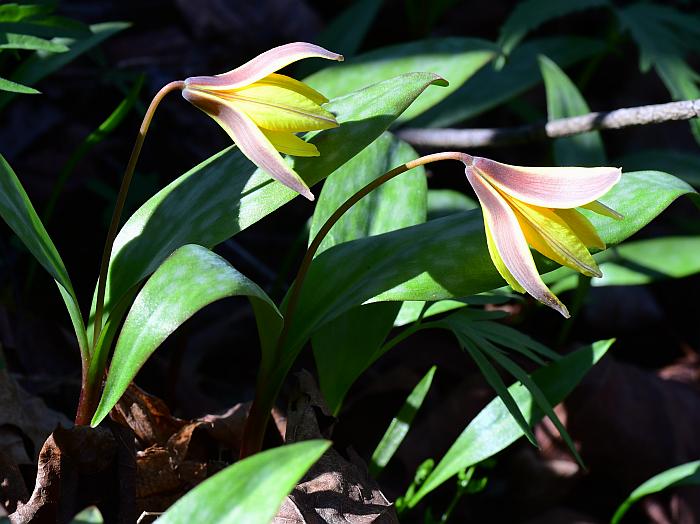Erythronium rostratum W. Wolf
Yellow Trout Lily

Native
CC = 8
CW = 3
MOC = 16
© SRTurner
Erythronium rostratum W. WolfYellow Trout Lily | |
 |
Native CC = 8 CW = 3 MOC = 16 |
© SRTurner |
|
Family - Liliaceae Habit - Perennial forb with deep-set bulblike corms, strongly colonial Leaves - Two leaves in flowering plants, one in vegetative plants, alternate but closely spaced, the blades spreading from near the middle of the partially subterranean aerial stems and thus appearing basal, the bases tapering into a sheath, 1.5-7.0 cm wide, lanceolate to narrowly ovate or elliptic, flat, not glaucous, usually mottled with brown.
Inflorescence - Solitary flower at the tip of the aerial stem.
Flowers - Perianth 15-50 mm long, broadly bell-shaped or arched outward, the sepals and petals free, lanceolate. Petals with a pair of well-developed, triangular appendages near the base, these wrapped around the filament of the opposing stamen. Stamens 6, free. Style 1, somewhat thickened near the tip, the 1 stigma 3-lobed, 0.5-1.5 mm long, the lobes stout and erect or nearly so. Ovary superior, with 3 locules, each with 8-20 ovules.
Fruits - Ellipsoid capsules, 10-25 mm long, weakly 3-angled, the tips tapered into a beak, positioned off the ground by the ascending or gradually spreading aerial stem that is variously bent upward near the tip, erect. Flowering - March - May. Habitat - Bottomland and mesic forests of ravines and valleys, shaded, lower ledges of bluffs. Origin - Native to the U.S. Lookalikes - E. americanum. Other info. - This attractive species is found in southern counties of Missouri, mostly on the western side of the state. Its global range is largely restricted to the lower Midwest and Southern states, and comprises a few apparently disjunct populations. In appearance the plant is much like E. americanum, except that the tepals are usually ascending to spreading but not reflexed. Also, a close look within the throat of the perianth will reveal distinct appendages at the base of the tepals, as shown in the photograph above. In favorable conditions the species can form very large populations which can cover multiple square acres of ground with thousands of vegetative single leaves. Flowering stems always have two leaves. Photographs taken at Roaring River State Park, Barry County, MO, 4-2-2021 (SRTurner). |